CLINICAL PARASITOLOGY

Clinical Parasitology Quiz
Test your knowledge of clinical parasitology with this comprehensive quiz featuring 84 questions covering various aspects of parasitic diseases and their identification.
This quiz is ideal for students and professionals in the field. Challenge yourself with questions that encompass:
- Diagnosis techniques
- Parasitic morphology
- Specimen collection methods
Disadvantage of formalin
Does not preserve parasite morphology in permanent smears
Long shelf life
Preserves specimens for up to several years
Polyvinyl alcohol is...
Used for concentration techniques
An adhesive for stool specimen
Used for fecal immunoassays
Macroscopic examination determines the?
Consistency
Color
Adult worms
All of the above
Direct wet prep can be eliminated from O&P exam if specimen is received in a fixative
True
False
Which of the ff. Parasitic stages is not usually detected after using a concentration technique?
Protozoan cysts
Protozoan trophozoites
Helminth eggs
Helminth larvae
What is 1 advantage of stool screening methods?
Highly sensitive and specific
Can detect all parasites
Can be performed on fresh or preserved specimens
Labor-intensive
From which area can the enterotest be used to collect specimens?
Duodenum
Sigmoid colon
Stomach
Perianal area
The specimen of choice for this parasite is mouth scrapings
Balantidium coli
Toxoplasma gondii
Trichomonas tenax
Entamoeba gingivalis
Thick blood smears for malaria are recommended for species identification
True
False
Giemsa is the prefered stain for the detection of blood parasites
True
False
Which of the following specimen of choice to demonstrate intracellular parasites such as T. Gondii and Leishamania spp.?
Sputum
Urine
Tissue
Genital secretions
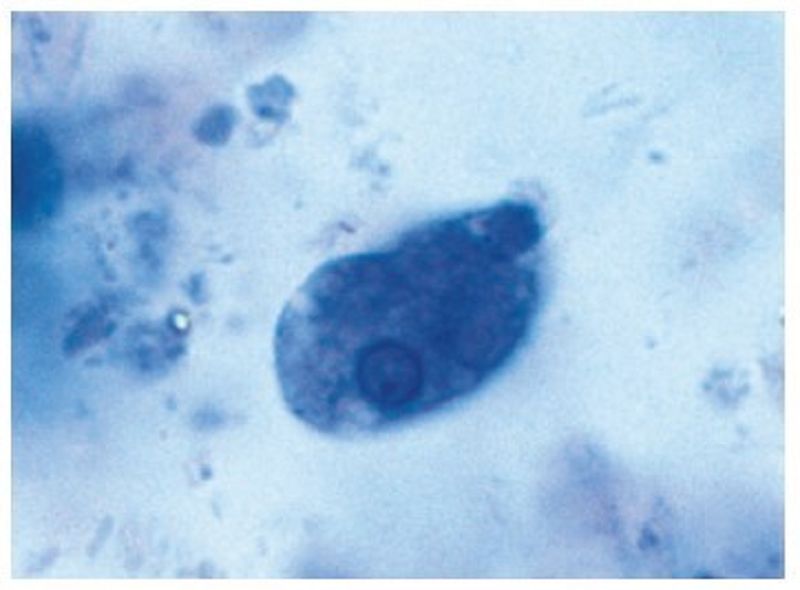
What is this parasite?
Entamoeba histolytica
Entamoeba coli
Entamoeba polecki
Iodamoeba butschlii
This parasite has a size range of 8-65 um. It has a progressive motility, one nucleus, small and central karyosome, fine and evely distributed peripheral chromatin, finely granular cytoplasm and ingested rbcs
Entamoeba histolytica
Entamoeba hartmanni
Entamoeba coli
Entamoeba polecki
This trophozoite has a size range of 8-25 um, sluggish, progressive unidirectional motility diarrheic stools, one nucleus, small and central karyosome, fine and evenly distributed peripheral chromatin, granular and vacuolated cytoplasm, and ingested bacteria
Entamoeba histolytica
Entamoeba polecki
Entamoeba hartmanni
Iodamoeba butschlii
This parasite have a size range of 5-12 um, a sluggish, nonprogressive, blunt pseudopods, one nucleus, large, irregular, blotlike karyosome, no peripheral chromatin, granular and vacuolated cytoplasm and ingested bacteria
Entamoeba histolytica
Entamoeba hartmanni
Endolimax nana
Iodamoeba butschlii
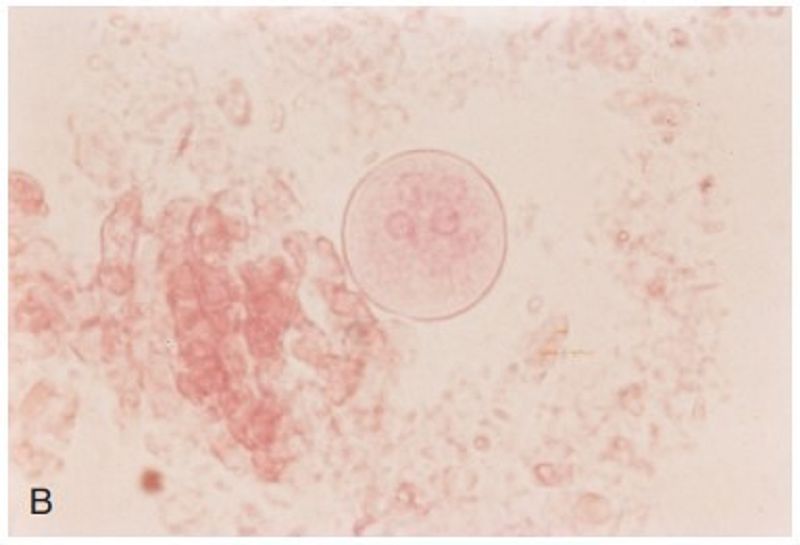
What is this parasite?
Entamoeba histolytica
Entamoeba coli
Entamoeba hartmanni
Iodamoeba butschlii
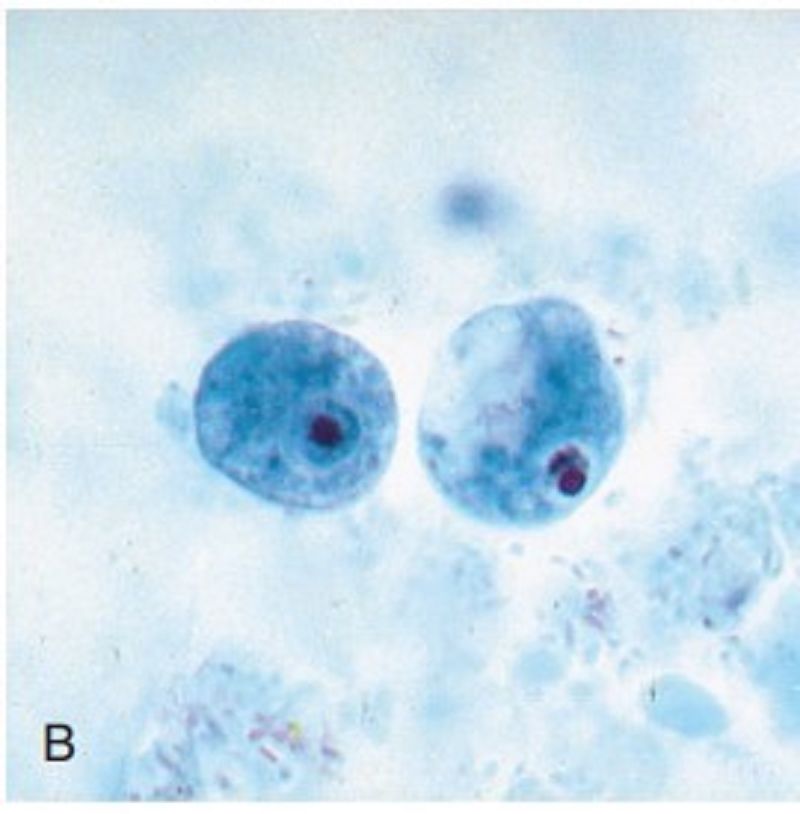
What is this parasite?
Entamoeba histolytica
Entamoeba coli
Entamoeba hartmanni
Iodamoeba butschlii
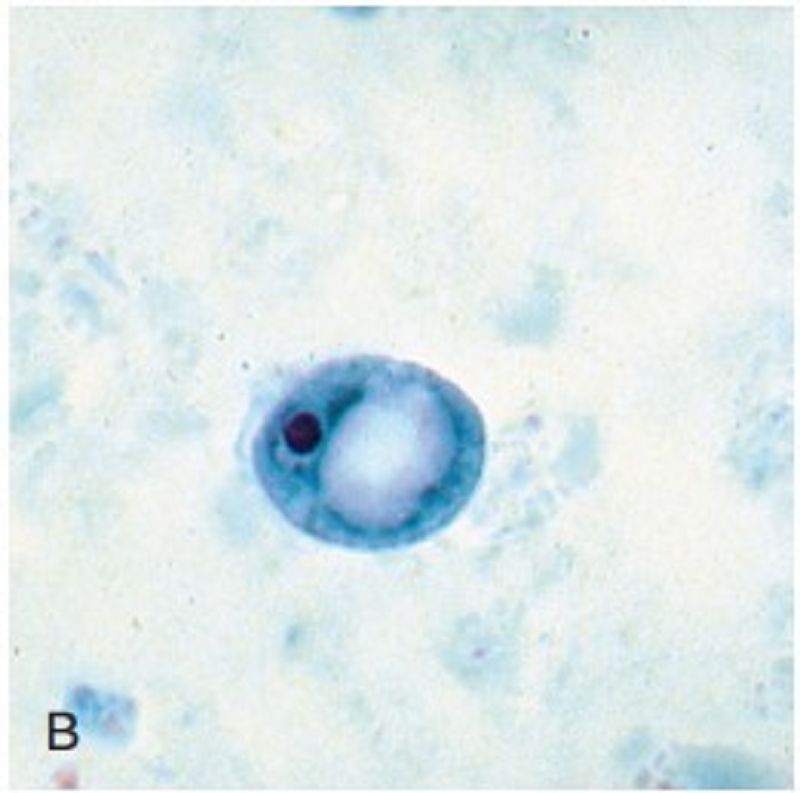
Identify this parasite
Entamoeba histolytica
Entamoeba coli
Entamoeba hartmanni
Iodamoeba butschlii
Iodamoeba butschlii cysts typically:
Contain four nuclei
Have a small karyosome in a central position
Lack chromatoid bars
Large glycogen vacuole
This protozoa has an amoeboid trophozoite
Entamoeba histolytica
Entamoeba gingivalis
Naegleria fowleri
Acanthamoeba
Specimen of choice for the recovery N. fowleri
Sputum
Stool
Csf
Urine
It is the causative agent of fatal meningoencephalitis
Entamoeba histolytica
Acanthamoeba
Naegleria fowleri
Entamoeba coli
This is the only protozoa with ragged cell wall
Entamoeba histolytica
Acanthamoeba
Naegleria fowleri
Entamoeba coli
Csf, brain tissue and corneal scrapings are the specimen of choice of this protozoa
Entamoeba histolytica
Acanthamoeba
Naegleria fowleri
Entamobea coli
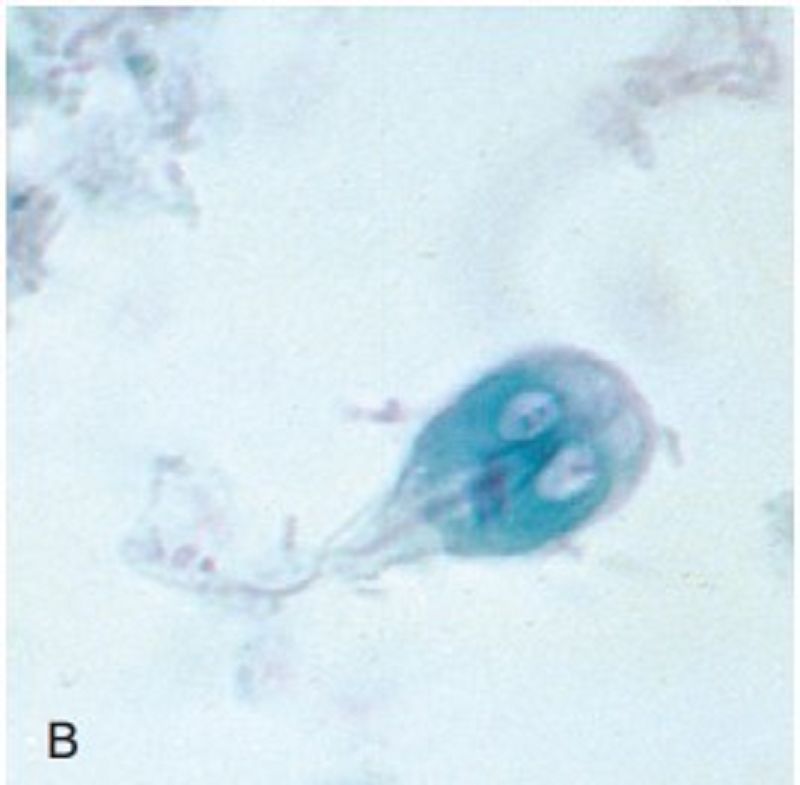
What is this parasite?
Giardia intestinalis
Chilomastix mesnili
Dientamoeba fragilis
Trichomonas hominis
G. Intestinalis trophozoites attach to the mucosa of the duodenum and feed with the assistance of this morphologic structure
Sucking disk
Axostyle
Axoneme
Nucleus
This parasite is 5-25 um long by 5-10 um wide, pear-shaped, stiff, rotary, directional motility, one nucleus with small central or eccentric karyosome with no peripheral chromatin and a prominent cytostome
Chilomastix mesnili
Giardia intestinalis
Dientamoeba fragilis
Trichomonas hominis
This protozoan cyst is 5-10 um long, lemon-shaped with a clear hyaline knob, one nucleus with large central karyosome, no peripheral chromatin and a well-defined cytostome
Giardia intestinalis
Dientamoeba fragilis
Chilomastix mesnili
Trichomonas hominis
This is the least likely specimen of choice for t. vaginalis
Urine
Urethral discharge
Vaginal discharge
Stool
The prominent structure found in t. Vaginalis trophozoites that often extends beyond the body provides the parasite with support
Nucleus
Axostyle
Axoneme
Granule
This parasite has a theory that it transmits via the eggs of helminth parasites
Giardia intestinalis
Chilomastix mesnili
Dientamoeba fragilis
Trichomonas hominis
The specimen of choice of this parasite can be urethral swab
Trichomonas hominis
Trichomonas vaginalis
Trichomonas tenax
Giardia intestinalis
Blood and tissue hemoflagellate
Malaria
Trypanosoma
Both the choices
Neither of the choices
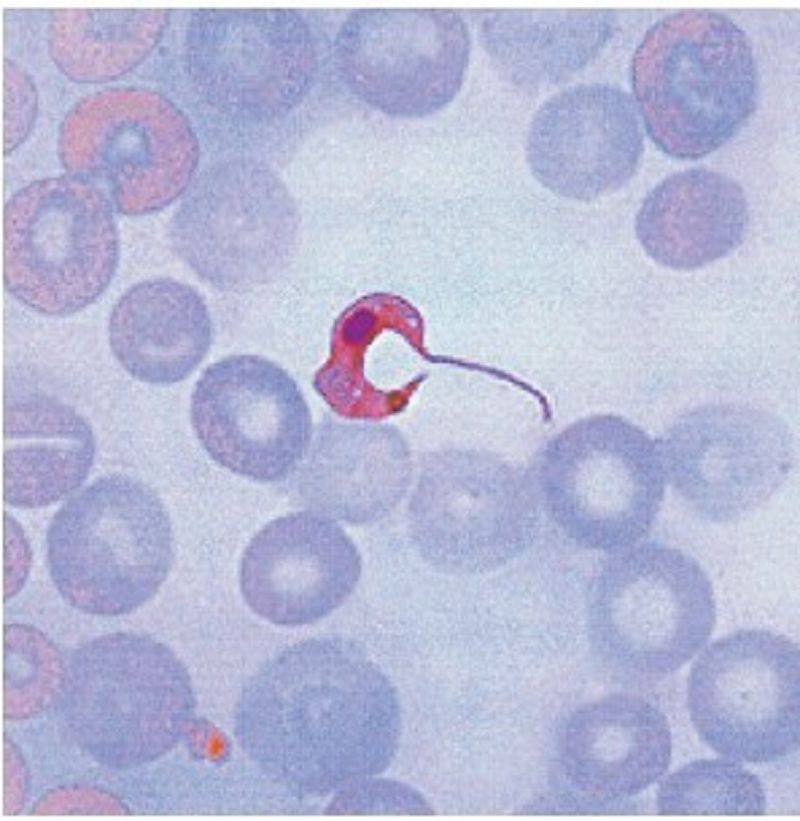
What is this parasite
Trypanosoma brucei gambiense
Trypanosoma brucei rhodiense
Trypanosoma cruzi
Trypanosoma rangeli
Baghdad boils is caused by what parasite
Leishmania donovani
Leishmania tropica
Leishmania mexicana
Leishmania braziliensis
Which of the following is not an acceptable treatment for mucocutaneous leishmaniasis caused by L. braziliensis?
Amoxcillin
Pentosam
Ambisome
Fungizone
Vector of dum dum fever (L. donovani)
Lutzomyia and Psychodopygus sandfly
Phlebotomus
Lutzomyia and phlebotomus sandfly
None of the above
?What is the causative agent of bay sore and chiclero ulcer
L. donovani
L. mexicana
L. braziliensis
L. tropica
Causative agent of west african sleeping sickness
T.b.gambiense
T.b. rhodiense
L. braziliensis
L. donovani
This shows symptoms of ulcer, fever, malaise, headache, lymphadenopathy, winterbottom's sign and kerandel's sign
T.b. gambiense
T.b. rhodiense
L. braziliensis
L. donovani
This shows symptoms of rapid weight loss, mental disturbance, lethargy, anorexia, kidney damage and myocarditis
T.b. gambiense
T.b. rhodiense
L. braziliensis
L. donovani
Which of the following trypanosomal parasites that causes sleeping sicknesses is the more aggressive form?
T.b. gambiense
T.b. rhodiense
T. cruzi
T. rangeli
Causative agent of Chagas' disease
T.b. gambiense
T.b. rhodiense
T. cruzi
T. rangeli
Vector is reduviid bug
T.b. gambiense
T.b. rhodiense
T. cruzi
T. rangeli
Can be transmitted by blood transfusion, sexual intercourse, and transplacentally
Mimics infectious mononucleosis
Balantidium coli
Toxoplasma gondii
Pneumocystis jiroveci
Cryptosporidium parvum
American trypanosomiasis causes
West african sleeping sickness
East african sleeping sickness
Chagas' disease
None of the above
Vector for chiclero ulcer
Lutzomyia and psychodopygus sandfly
Phlebotomus sandfly
Lutzomyia and phlebotomus sandfly
None of the above
Causes less aggressive sleeping sickness
T.b. gambiense
T.b. rhodiense
T. cruzi
T. rangeli
Dormant plasmodium-infected liver cells
Sporozoites
Merozoites
Hypnozoites
Sporocysts
The infective stage of Plasmodium is (are) the
Merozoite
Oocyst
Sporozoites
Gametocytes
It occupies 75% of RBC, rosette shaped, 8 merozoites
P. vivax
P. ovale
P. malariae
P. falciparum
P. Vivax characteristically invades:
Immature RBCs
Senescent RBCs
All RBCs
Lymphocytez
Which morphologic form would be the best choice for distinguishing between P. Vivax and P. ovale?
Mature schizont
Ring form
Early trophozoite
Immature schizont
Causative agent of black water fever
P. vivax
P. ovale
P. malariae
P. falciparum
This parasite has a scanty cytoplasm, headphone configuration, sausage or crescent shaped gametocyte, multiple rings, accole
P. vivax
P. ovale
P. malariae
P. falciparum
What age of red blood cell does P. Falciparum typically invade?
Mature
Immature
All
Does not invadr RBCs
P. Knowlesi morphologically resembles
P. vivax
P. ovale
P. malariae
P. falciparum
Babesia trophozoites resembles
Ring form of plamodium infections
P. Ovale ring form
P. Vivax gametocytes
Developing trophozoite of P. falciparum
Looks like a maltese cross
Plasmodium
Babesia
Leishmania
Trypanosoma
What is more severe?
B. microti
B. divergens
P. vivax
P. ovale
Sever in older aldults, immunocompromised and splenectomized patients
Plasmodium
Babesia
Leishmania
Trypanosoma
Vectors are ticks
Babesia
Plasmodium
Leishmania
Trypanosoma
Which of the following are laboratory diagnostic pro- cedures is recommended for specifically identifying T. microti?
Thick and thin blood films
Serologic testing
PCR techniques
Both B and C are correct.
None of the above
For which patient would babesiosis be more severe?
Splenectomized
Patient with B. divergens
Older adults
All of the above
Vector of plasmodium spp.
Aedes
Reduviid bug
Anopheles
Ticks
Self-limiting infection,gradual onset of headache, chills, sweats, and fatigue
P.ovale
B. microti
B. divergens
P. vivax
Sexual reproduction of ticks happens in
Host
Ticks
Gametocytes
Intestine
Only human pathogen of ciliates
Balantidium coli
Cryptosporidium parvum
Blastocystis hominis
Toxoplasma gondii

What is this parasite?
P. vivax
P. ovale
P. malariae
P. falciparum
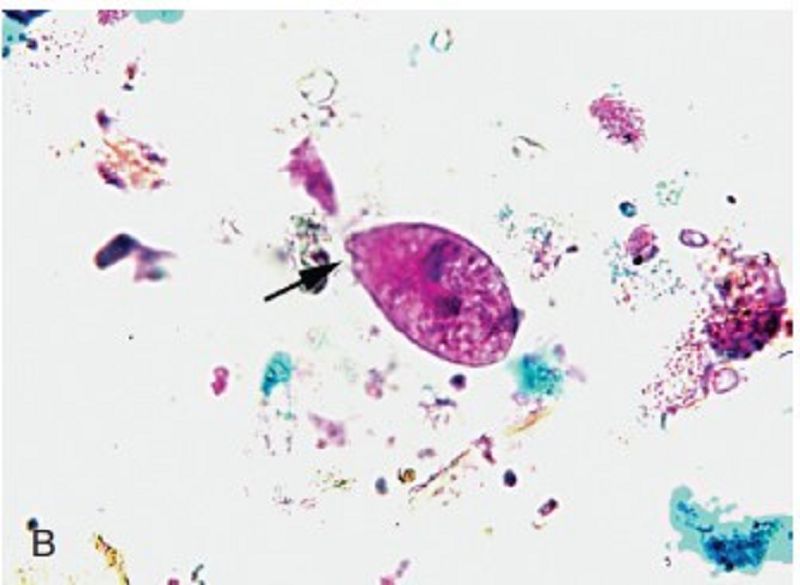
What is this parasite?
Balantidium coli
Toxoplasma gondii
Cryptosporidium parvum
Cyclospora cayetanensis
This parasite is 25-35 um long and 10-15 um wide with transparent oval shape, 2 layered colorless smooth cell wall, unicellular sporoblast and 2 sporocysts each containing four sausage-shaped sporozoites
Balantidium coli
Sarcocystis spp.
Cystoisospora belli
Cryptosporidium parvum
The specimen of choice of this parasite is fresh feces or duodenal aspirate
Balantidium coli
Sarcocystis spp.
Cystoisospora belli
Cryptosporidium parvum
Sarcocystis resembles
Balantidium coli
Sarcocystis spp.
Cystoisospora belli
Cryptosporidium parvum
The permanent stain of choice for the recovery of Cryptosporidium parvum is:
Iron hematoxylin
Modifed acid-fast
Gram
Trichrome
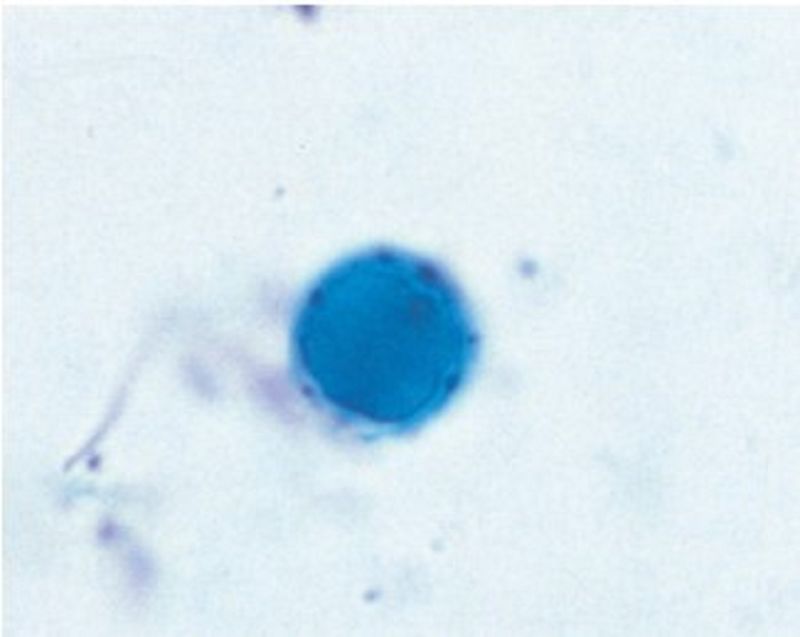
What is this parasite?
Balantidium coli
Sarcocystis spp.
Blastocystis hominis
Cyclospora cayetanensis
The MOT of this parasite is through eating basil and raspberries
Balantidium coli
Blastocystis hominis
Sarcocystis spp.
Cyclospora cayetanensis
C. Cayetanensis infection is similar to
Balantidium
Cryptosporidium
Blastocystis
Sarcocystis
Definitive host of this parasite is a cat
Balantidium coli
Blastocystis hominis
Toxoplasma gondii
Sarcocystis
Sporozoan oocyst with no sporocyst
Balantidium
Cryptosporidium
Blastocystis
Sarcocystis
Scientific name for the sexual reproduction
Schizogony
Gametogony
Zygote
Gametocyes
Only parasite with 2 nuclei
Balantidium
Blastocystis
Cryptosporidium
Sarcocystis
Only parasite with cilia
Balantidium
Cryptosporidium
Blastocystis
Sarcocystis
The primary means of diagnosing this infection is analyzing blood samples using serologic test methods
Balantidium
Cryptosporidium
Blastocystis
Toxoplasma
{"name":"CLINICAL PARASITOLOGY", "url":"https://www.quiz-maker.com/QPREVIEW","txt":"Test your knowledge of clinical parasitology with this comprehensive quiz featuring 84 questions covering various aspects of parasitic diseases and their identification.This quiz is ideal for students and professionals in the field. Challenge yourself with questions that encompass:Diagnosis techniquesParasitic morphologySpecimen collection methods","img":"https:/images/course6.png"}
More Quizzes
Micro exam 2019/20
603041
GENUS STAPHYLOCOCCUS
11613
Do you have any recommendations in new papers today?
100
Guess Who???
14712
Free Officer Term Length
201021671
Ace the Rosa Parks: Chapters 7-9 Comprehension
201025407
Test Weather Knowledge with Our Ultimate Weather
201038575
Magical Harry Potter Objects: Prove Your Mastery!
201036269
Augmentative & Alternative Communication
15825407
Can You Master the Chemistry Unit 6 Test? Take the!
201027144
Master Spanish -AR -ER -IR Verbs: Free Conjugation
201023923
A Rice Sandwich: Test Your Sandra Cisneros Knowledge
201026117